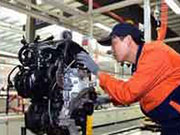NPC deputies: Supply-side reform urgently needed

 0 Comment(s)
0 Comment(s) Print
Print E-mail CNTV, March 4, 2016
E-mail CNTV, March 4, 2016
One of the focuses for Chinese lawmakers and advisors is supply-side reform.
China is moderately expanding overall demand and intensifying supply-side structural reform.
Previously, the country has adopted a development strategy to stimulate economy and that is through investment, consumption, and export.
But with the rise in productivity, things have changed. Overcapacity, rising home prices, mounting local government debt, and the lack of high-end products are just some of the economic problems China faces.
But to address these, the government needs to improve the domestic supply of goods to bolster growth.
"2016 marks the beginning of the 13th Five Year Plan. The government's policy on supply-side reform comes at the right time. Many industrial companies, especially the steel sector, urgently need to de-stock overcapacity, as well as to reorganize," NPC deputy He Daping said.
The aim of the supply-side reform is to optimize the allocation of production components and boost the economic growth quality. But it is not an easy task.
"The government's guidance on the supply-side reform will effectively encourage enterprises to innovate," NPC deputy Wang Liping said.
"The government should do more to support companies on technology-innovation, for example, by cutting taxes and by streamlining bureaucracy. That will make the market play a decisive role in resources allocation which will benefit companies, as well as to make them more competitive."
The supply-side reform has been actively promoted by China's top leaders. China will adopt a series of measures to increase good quality products to fit demand. And the ultimate goal is that China can optimize the economic structure and achieve sustainable development.





